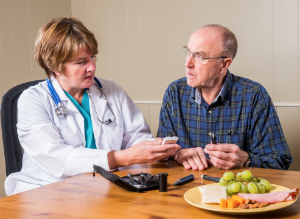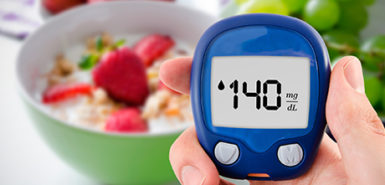
Diabetes rates have quadrupled worldwide, but that doesn’t mean knowledge about the disease has grown at the same pace.
Patients often come in with misconceptions about what a diabetes diagnosis means and how it will affect daily life, says Jen Krzyszkiewicz, RD, CNSC, a diabetes educator with Spectrum Health Medical Group.
Here, she clears up the three most common myths she encounters. And she provides two helpful tips.
Myth: You have to ditch the carbs
Truth: Carbs are still good for you
“One of the biggest misconceptions is that you have to eliminate carbohydrates,” Krzyszkiewicz says. “I have a lot of people coming in saying, ‘I am working to get the bread out. I’m trying not to eat potatoes.”
But carbs aren’t the enemy.
“They are one of the main energy sources for the body,” she says. “They are important for our body functions.”
Diabetes worldwide
The number of adults living with diabetes worldwide quadrupled since 1980, according to the World Health Organization’s global report on diabetes released in April. The report finds:
• The rise is linked, in part, to increases in the number of people who are overweight and a widespread lack of physical activity.
• Type 2 diabetes accounts for most diabetes cases. Higher body mass index and higher waist circumference are linked to increased risk for Type 2 diabetes.
• Possible complications include heart attack, stroke, kidney failure, vision loss and nerve damage.
• People can reduce their risk for diabetes with a healthy diet and 30 minutes of moderate-intensity physical activity on most days.
She advises patients to eat three meals a day and have some carbohydrate at each meal. She advises sensible portion sizes. If people try to eliminate the entire carb food group, they likely will feel drained of energy.
And the drastic change can lead to feelings of deprivation. Krzyszkiewicz advises incremental changes, rather than drastic ones.
Myth: Insulin = failure
Truth: Diabetes is a progressive disease
Patients with Type 2 diabetes often manage their condition with diet, exercise and oral medications to overcome insulin resistance.
Sometimes, they reach the point where they need insulin injections. And when that happens, patients often feel a sense of failure.
“It’s definitely stressful for them,” Krzyszkiewicz says.
She lets patients know diabetes is a progressive disease. Even if a patient “does everything right,” the pancreas may wear down and become unable to produce enough of the insulin hormone the body needs.
Rather than seeking insulin as a symbol of failure, she suggests patients should view it as one more tool in their toolbox—one that can help them live a healthy life.
Myth: You have to follow the ‘diabetic diet’
Truth: There is no ‘diabetic diet’
Often, newly diagnosed patients believe they must bid farewell to their favorite foods. No more birthday cake. No chips. No sweets.
Some come in with the idea they will be told to follow a bland, boring “diabetic diet”―and they aren’t happy about it.
Krzyszkiewicz tells them: “There is no diabetic diet.”
She teaches patients about healthy eating and how to count their carbohydrates to control blood sugar. But she also assures them, “We can make all foods fit.”
“You can still celebrate birthdays and have special occasions. We may suggest that they choose healthier items and maybe less of something, but there is nothing they can’t have any more.”
Rather than an all-of-nothing approach to change, she advises finding the middle ground. She helps patients set small, achievable goals that work with their current eating patterns.
Managing diabetes is not all about diet, she adds. Lifestyle changes come into play. Regular exercise, good sleep patterns and stress management all can help people manage blood sugar levels.
Tip 1: Know your risk for diabetes
Rates of Type 2 diabetes―once called adult-onset diabetes―have risen along with obesity rates. Although being overweight is a risk factor for the disease, it is not the only one.
You don’t have to be overweight to get diabetes.
The disease has a genetic component, so Krzyszkiewicz suggests looking into family medical history.
She also cautions people to check with their doctor if they experience the signs of diabetes: increased thirst, increased urination, blurry vision and rapid weight loss. Early detection and treatment can lead to better health outcomes.
Tip 2: Get informed
Diabetes is a serious disease. It doubles the risk of having a heart attack and can damage the eyes, blood vessels and kidneys. But those with diabetes can reduce their risk of complications with a healthy diet, regular physical activity and by maintaining a normal body weight, according to the World Health Organization.
Krzyszkiewicz advises patients become informed about the disease. Tap resources available―such as their doctor, the American Diabetes Association and the Spectrum Health Medical Group Diabetes & Endocrinology department to learn ways to manage it.
 /a>
/a>
 /a>
/a>
 /a>
/a>